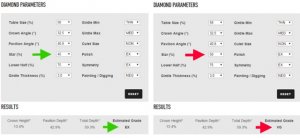Hi all,
I am getting a proposal ring for my girlfriend. She's in the dark, but I know she's not the picky sort and will be over the moon with anything I present to her.
I've paid a deposit for this gem: http://www.gia.edu/cs/Satellite?reportno=5146657022&childpagename=GIA%2FPage%2FReportCheck&pagename=GIA%2FDispatcher&c=Page&cid=1355954554547
Diamond Dossier
0.64 carat
F
VS1
GIA, triple excellent
Proportions
Depth: 62.3 %
Table: 56 %
Crown Angle: 35.5°
Crown Height: 15.5%
Pavilion Angle: 41.0°
Pavilion Depth: 43.5%
Star Length: 50%
Lower Half: 80%
Girdle: Medium, Faceted, 3.5%
Culet: None
To the naked eye, everything seemed ok, and the prices quoted were pretty cheap compared to local prices here. When I checked the HCA scores, I realise that it scores below par, 3.8. Now, to my eye, it looks better than a HCA gem that I compared with that scored 2.2.
Should I be worried about the HCA score? Hard to understand why a triple excellent can get such a low HCA score?
Thanks in advance guys!
I am getting a proposal ring for my girlfriend. She's in the dark, but I know she's not the picky sort and will be over the moon with anything I present to her.
I've paid a deposit for this gem: http://www.gia.edu/cs/Satellite?reportno=5146657022&childpagename=GIA%2FPage%2FReportCheck&pagename=GIA%2FDispatcher&c=Page&cid=1355954554547
Diamond Dossier
0.64 carat
F
VS1
GIA, triple excellent
Proportions
Depth: 62.3 %
Table: 56 %
Crown Angle: 35.5°
Crown Height: 15.5%
Pavilion Angle: 41.0°
Pavilion Depth: 43.5%
Star Length: 50%
Lower Half: 80%
Girdle: Medium, Faceted, 3.5%
Culet: None
To the naked eye, everything seemed ok, and the prices quoted were pretty cheap compared to local prices here. When I checked the HCA scores, I realise that it scores below par, 3.8. Now, to my eye, it looks better than a HCA gem that I compared with that scored 2.2.
Should I be worried about the HCA score? Hard to understand why a triple excellent can get such a low HCA score?
Thanks in advance guys!









300x240.png)